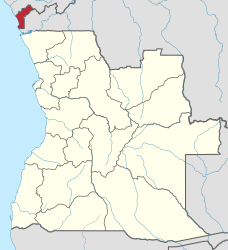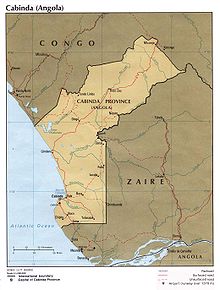Cabinda Province
| Cabinda Province | ||
|---|---|---|
| Symbols | ||
|
||
| Basic data | ||
| Country | Angola | |
| Capital | Cabinda | |
| surface | 7823 km² | |
| Residents | 824,000 (2019) | |
| density | 105 inhabitants per km² | |
| ISO 3166-2 | AO-CAB | |
| Website | www.cabinda.gov.ao ( Portuguese ) | |
| politics | ||
| Governador | Marcos Alexandre Nhunga | |
Coordinates: 5 ° 3 ′ S , 12 ° 18 ′ E
Cabinda (also: Kabinda; formerly Portuguese Congo ) is a province and exclave of the African state Angola . The capital is the city of the same name .
population
The population belongs to the Bakongo , a Bantu people, namely to the subgroups of the Kakongo, Vili, Oyo and Yombe. In 2007 about 300,000 people lived in Cabinda. The population growth is very high. The 2014 census showed 716,000 inhabitants, the estimate for 2019 is 824,000 inhabitants.
geography
Cabinda is located west of the Lower Guinea Sill in the natural area of the Zaire lowlands and covers 7270 square kilometers. The main town and port next to Malembo is the town of the same name, Cabinda .
The province is separated from the main state of Angola by a narrow strip of the Democratic Republic of the Congo ( Congo-Kinshasa ) , which thus has access to the Atlantic . There are the border crossings Yema, Beira Nova, Chimbuandi and Chiobo. The demarcation goes back to the three historical kingdoms Loango , Ngoyo and Kakongo and was established in 1885 at the Congo Conference in Berlin . In the north, Cabinda borders the Republic of the Congo (French Congo) , with the border crossings Massabi and Miconje.
economy
The most important branch of the economy is the oil industry . Funding began in 1968. Cabinda has the largest share of Angolan's oil production. The proceeds of the Cabindian oil production make up 80% of the Angolan financial budget. The Agriculture Cabinda produced for export mainly coffee , cocoa and palm oil . In addition, precious woods are exported.
education
The level of education in the province is relatively high. The literacy rate is 79.8%, of the residents over the age of 24, 3.8% have a university degree. This puts Cabinda in second place nationwide, only surpassed by the province of Luanda with 5.4%. The Universidade 11 de Novembro and the Universidade Católica de Angola are located in Cabinda city . Unemployment is still 32%, the third highest in Angola.
history
Portuguese Congo
In 1853 and 1854, Portuguese emissaries received Cabindian princes and notables on three occasions . The third time they were greeted as ambassadors for their country with 21 gun salutes. The Luso-Cabindian treaties were concluded from 1883 to 1885: the first two between the Portuguese and Cabinda on September 29, 1883 in Chinfuma and on November 26, 1884 in Chicamba . With the Treaty of Simulambuco of February 1, 1885, the area became the Portuguese protectorate of Kakongo, Luango and Ngoio or the territories north of the Congo . According to this treaty, the local rulers asked Portugal for its protection. This was confirmed by the Luso-Cabindic Treaty and at the Congo Conference in Berlin in 1885 that the Congo was divided into three by the other colonial powers . So the Portuguese trading post came to its hinterland and became a state area. The two colonial powers France and Portugal laid down the exact boundary between their possessions in a treaty dated May 15, 1886.
Incorporation in Angola
After Portugal finally negotiated Angola's borders and effectively occupied the territory in the mid-1920s, it began treating Cabinda as part of that colony. After the Basic Law of 1933 clearly differentiated between the Colony of Angola and the Protectorate Cabinda, in 1956 it transferred the administration of the Protectorate to the Governor General of Angola. The distinction between the two different statuses remained de jure and was expressed again in the Portuguese constitution of 1971. When Angola was granted the status of an "overseas province" (Província Ultramarina) of Portugal in 1951 and that of the "Estado de Angola" ("State of Angola") within the Portuguese empire in 1972, Cabinda was treated as a normal district of Angola.
Remain in independent Angola
When the resistance against the colonial power Portugal began to form in Angola in the 1950s, anti-colonial groups also formed in Cabinda, although most of them were striving for independence from Angola. Most of these groups joined together in 1962 to form the "Frente de Libertação do Enclave de Cabinda ( FLEC )" (Liberation Front for the Cabinda Enclave). However, this was not able to take part in the armed struggle and was limited to a certain degree of political mobilization in the underground and in exile. From the mid-1960s onwards, however, the Movimento Popular de Libertação de Angola (MPLA) waged a guerrilla war (albeit less intense) in Cabinda from the Republic of Congo, and there were also attempts by the rival Frente Nacional de Libertação de Angola ( FNLA ). to show a sporadic presence in Cabinda from Zaire . The low success of the anti-colonial efforts in Cabinda was due not least to the fact that in 1963 important oil deposits were discovered off the coast of Cabinda and the colonial troops stationed there were then considerably increased.
When Portugal initiated the decolonization of Angola in 1974 after the Carnation Revolution , an armed conflict arose in 1974/75 between the nationalist liberation movements FNLA, MPLA and UNITA (União Nacional para a Libertação Total de Angola). The FLEC played only a very minor role in this context. In the course of the conflict, the MPLA occupied Cabinda in order to secure access to the oil reserves. When Angola's independence was proclaimed by the MPLA (in Luanda ) and by FNLA and UNITA (in Huambo ) in November 1975, while the armed conflict was still ongoing, none of the warring movements questioned that Cabinda was and should remain part of Angola.
In the meantime, however, the FLEC had not remained politically inactive. In 1974 Cabinda was designated by the Organization for African Unity (OAU) as the 39th state in Africa and to be decolonized. However, this had no practical consequences, just as little as the fact that the "Republic of Cabinda" proclaimed by the FLEC became a member of the Unrepresented Nations and Peoples Organization (UNPO).
During the civil war in Angola from 1975 to 2002, the FLEC was reorganized, but with different competing wings. This also included a military arm, the "Forças Armadas de Cabinda" (FAC, Cabindas Armed Forces), which for a time carried out occasional guerrilla operations against the Angolan state, which was now ruled by the MPLA. In addition, there has been a certain degree of political mobilization, especially since the 1990s, which also received support from civil society and the church, to which the MPLA reacted with consistent repression.
Overall, the activities of the FLEC declined sharply in the 2000s. On January 8, 2010, however, they carried out a bloody attack on the Togolese national soccer team when they were on their way to the 2010 African Cup in Angola. In the process, she killed three delegates and injured other players and coaches. The Togolese national football team did not take part in the African Championship.
In the course of the immediate pursuit, the Angolan military succeeded in arresting the FLEC / FAC chief of staff in February 2011. This should mean the end of armed resistance on the part of the FLEC. At the end of March 2011, however, the demand was repeated from circles of the Catholic Church in Cabinda to hold a referendum in Cabinda about whether they wanted to remain part of Angola or become separately independent. Shortly thereafter, however, the Vatican appointed a bishop for Cabinda who did not come from there, and removed three Cabinda clergy from their priesthood who had campaigned for the independence of the exclave. It is therefore questionable to what extent there will be resistance from civil society in the future.
In the meantime the Angolan regime has taken certain "calming measures". The province of Cabinda now receives a slightly higher share from the oil income and an autonomous state university (“Universidade 11 de Novembro”) has been established in the city of Cabinda.
administration
450,460 inhabitants live in the province of Cabinda on an area of 7270 km². The capital of the province is Cabinda (city) .
The following districts ( Municípios ) are in the Cabinda Province:
Personalities
- Waldemar Bastos (1954-2020), Angolan singer
- Damião António Franklin (1950–2014), Catholic Archbishop of Luanda
literature
- Kabinda . In: Encyclopædia Britannica . 11th edition. tape 15 : Italy - Kyshtym . London 1911, p. 623 (English, full text [ Wikisource ]).
Web links
- Official website of the provincial government
- Cabinda - pictures
- Oil production (chevron)
- Oil production (Roc Oil Company)
- Cabinda.net - Unofficial site with lots of links
Individual evidence
- ↑ See José Redinha: Etnias e culturas de Angola , Instituto de Investigação Científica de Angola, Luanda 1975
- ↑ Population statistics citypopulation.de , accessed on June 11, 2019.
- ↑ SME in Cabinda issues tourist visas on land border of Massabi angop.ao , January 23, 2019, accessed on July 10, 2019
- ↑ Results of the 2014 census (PDF) pp. 54–58, info-angola.com , accessed on June 11, 2019.
- ↑ Results of the 2014 census (PDF) p. 64, info-angola.com , accessed on June 11, 2019.
- ↑ Bulletins Officiels d'Angola n ° 388, March 5, 1853, p. 2; n ° 483, December 30, 1854, pp. 1-2; n ° 571, September 6, 1854, pp. 4-5.
- ↑ cabinda.org: Histoire du Cabinda
- ↑ Kabinda . In: Meyers Konversations-Lexikon . 4th edition. Volume 9, Verlag des Bibliographisches Institut, Leipzig / Vienna 1885–1892, p. 346.
- ↑ Histoire de Cabinda. ( Memento from April 26, 2005 in the Internet Archive ) Nekongo
- ↑ See John Marcum: The Angolan Revolution , Volume I, The Anatomy of an Explosion (1950–1962). MIT Press, Cambridge, Mass. / London 1969.
- ^ John Marcum: The Angolan Revolution , Volume II, Exile Politics and Guerrilla Warfare (1962–1976). MIT Press, Cambridge MA / London 1978.
- ^ Franz-Wilhelm Heimer : The decolonization conflict in Angola. Weltforum Verlag, Munich 1979
- ^ Jeune Afrique Économie May 4, 1998.
- ↑ UNPO
- ^ O País (Luanda), March 7, 2011
- ↑ Público (Lisbon), March 18, 2011
- ↑ Público (Lisbon), May 25, 2011
- ↑ Profile of Cabinda Province on the Angola 2014 Census website, accessed March 15, 2014





